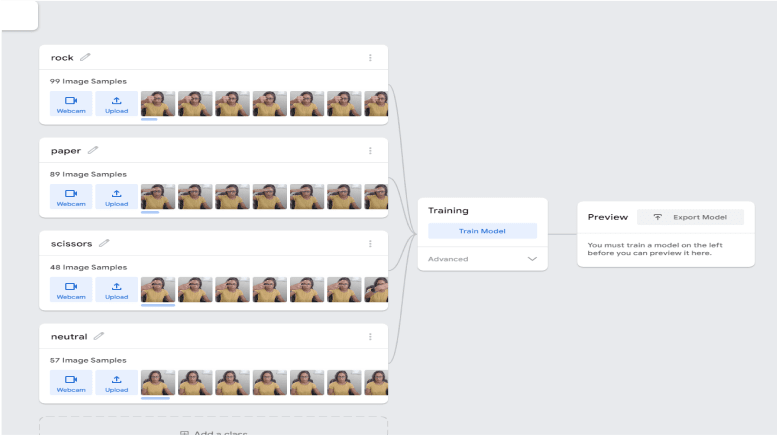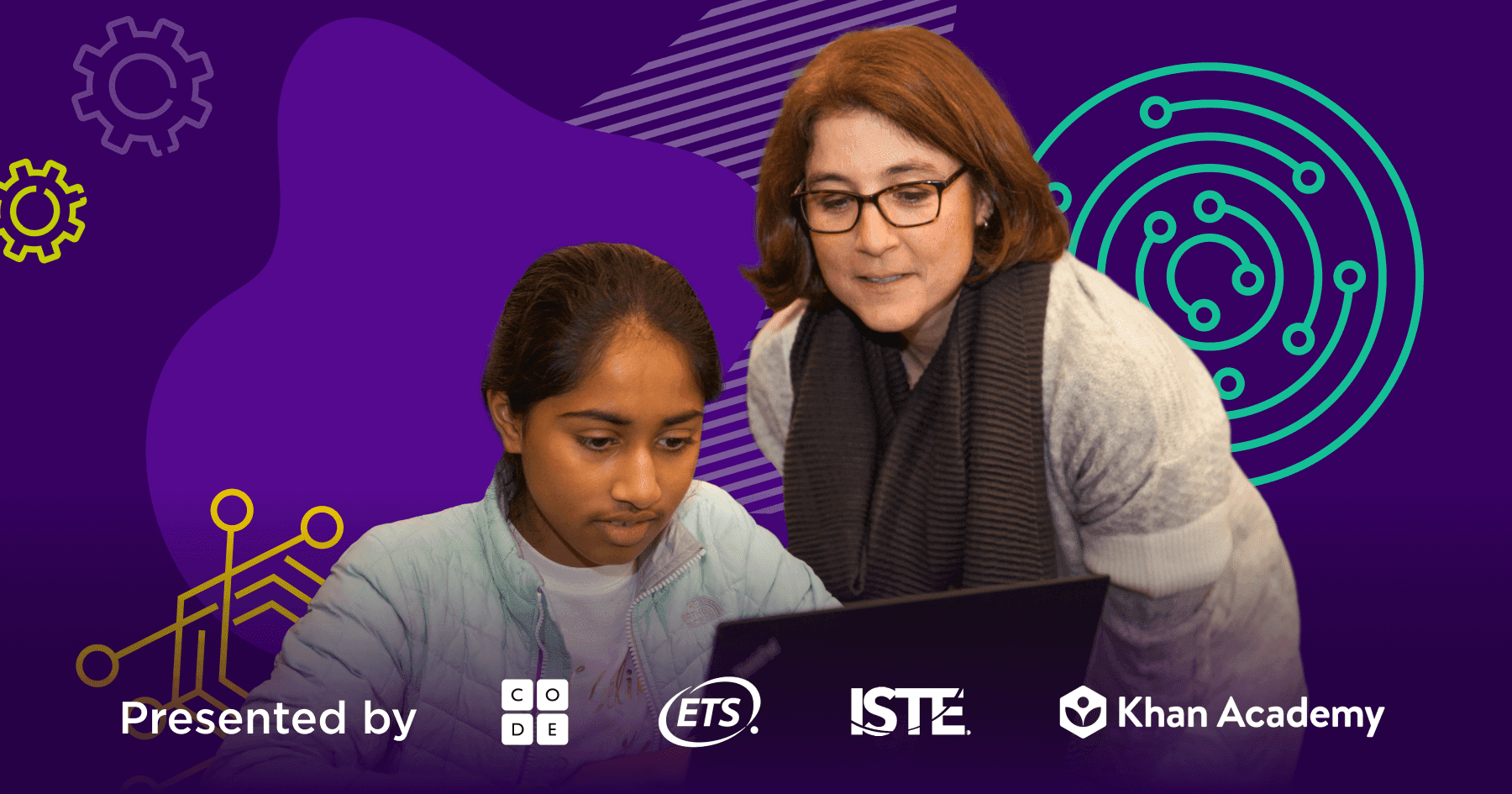Teach
About
Privacy & Legal
Grades: 9-12
Level: Advanced
Duration: 2 weeks
Devices: Laptop, Chromebook
Topics: Topics: Programming, Data, Art and Design, Games and Animation
Programming Tools: Programming Tools: Github, Github Copilot, VSCode, TensorFlow
Professional Learning: None
Accessibility: See FAQ section for details
Languages Supported: English
Students learn how to use GitHub Copilot as a pair programmer to explain existing code, find and fix errors, and generate solutions to new problems.
Learn more about Copilot

Students train their own AI models using Teachable Machine to recognize images and gestures form a webcam and consider how computer vision impacts the way users interact with apps.
Explore the lesson planStudents implement the AI models they created with Teachable Machine into a Java app, using GitHub Copilot to help them modify existing versions of apps to work with the different inputs.
See an example

Sign up for a Code.org account to get access to materials that will help you teach computer science with confidence. Code.org has extensive resources designed to support educators, even those without prior CS teaching experience.

Get step-by-step guidance, learning objectives, and assessment strategies for effective teaching.
Helpful resources include slide decks, activity guides, rubrics, and more — all organized in one place. Each lesson plan is accompanied by tips for classroom implementation, differentiation ideas, and extension activities to cater to students of all abilities.
Explore example lesson plan
Watch easy-to-understand overviews of computer science and programming concepts.
Code.org video series are designed specifically to support your classroom and are engaging and fun to watch.
Explore all videosWe offer educators an organized, visually engaging, and pedagogically sound framework to deliver computer science lessons.
Code.org slide decks provide step-by-step instructions, examples, and interactive activities that align with curricular objectives.
Explore example slide deck
Our curricula includes a comprehensive system of formative and summative assessment resources.
These include rubrics, checklists, mini-projects, end-of-chapter projects, student-facing rubrics, sample projects, and post-project tests — all designed to support teachers in measuring student growth, providing feedback, and evaluating student understanding.
Explore an assessment lesson
Code.org's integrated development environments (IDEs) cater to students of all skill levels.
We offer a versatile and user-friendly platform that supports a variety of programming paradigms. This enables learners to seamlessly transition from block-based coding to text-based languages, and fosters creativity and innovation.
Try out programming tools
Get step-by-step guidance, learning objectives, and assessment strategies for effective teaching.
Helpful resources include slide decks, activity guides, rubrics, and more — all organized in one place. Each lesson plan is accompanied by tips for classroom implementation, differentiation ideas, and extension activities to cater to students of all abilities.
Explore example lesson plan
Watch easy-to-understand overviews of computer science and programming concepts.
Code.org video series are designed specifically to support your classroom and are engaging and fun to watch.
Explore all videosWe offer educators an organized, visually engaging, and pedagogically sound framework to deliver computer science lessons.
Code.org slide decks provide step-by-step instructions, examples, and interactive activities that align with curricular objectives.
Explore example slide deck
Our curricula includes a comprehensive system of formative and summative assessment resources.
These include rubrics, checklists, mini-projects, end-of-chapter projects, student-facing rubrics, sample projects, and post-project tests — all designed to support teachers in measuring student growth, providing feedback, and evaluating student understanding.
Explore an assessment lesson
Code.org's integrated development environments (IDEs) cater to students of all skill levels.
We offer a versatile and user-friendly platform that supports a variety of programming paradigms. This enables learners to seamlessly transition from block-based coding to text-based languages, and fosters creativity and innovation.
Try out programming tools
Discover the groundbreaking world of Artificial Intelligence (AI) and its transformative potential in education with our comprehensive online learning series for teachers.
Watch the AI 101 for Teachers seriesBefore diving into this module, students should possess an entry-level knowledge of Java. Specifically, they should a grasp on:
Ideally, students who have completed AP Computer Science A or a course of similar depth and rigor would be well-prepared for this module.
This module is unique because it involves the use of third-party software rather than Code.org labs and tools. Read more about installing the software here.
Catering to accessibility needs is crucial for an inclusive learning environment. Read more about accessibility features in the software used in this module here.
Using VS Code on a Chromebook has become more straightforward, especially with the capability to run Linux apps on newer Chromebook models. Read more about setting up VS Code on Chromebooks here.
There is not currently specific professional development for this course. If you are looking to understand how to approach Artificial Intelligence in your classroom you can explore AI 101 for Teachers.
The Software Engineering & Computer Vision module is thoughtfully structured to provide comprehensive learning in a concise timeframe. The entire module is designed to span 2 weeks of instruction. Most lessons are tailored for 45 minutes, while lessons where students delve into hands-on Java project development are designed for 90 minutes. This extended time ensures students have ample opportunity to understand, implement, and troubleshoot as they work.
There is also intentional flexibility built into the module's structure. Depending on the classroom dynamics, student engagement, and the depth to which you'd like to explore each topic, you can adjust the duration. For example, the Intro to Copilot lesson, designed as a 45 minute lesson, can be expanded to 90 minutes if you wish to dive deeper into how large language models and tools like GitHub Copilot and ChatGPT work.
With an approved teacher account, you can find answer keys in a blue "Teacher" Only panel that shows in the online lessons and activities.If you need an approved teacher account, you can apply for access to protected teacher-only materials (answer keys, etc) through this form. Please keep in mind that it may take 3-5 business days to verify your account.
Yes, the Software Engineering & Computer Vision curriculum is mapped to the CSTA K-12 Standards and the AI for K-12 Guidelines.
Our curriculum and platform are available at no cost for anyone, anywhere, to teach!
Additionally, the software and tools used in this module are free of charge. GitHub Copilot is free for verified teachers and students.
Facing issues during software installation can be common, but there are systematic steps you can follow to troubleshoot and resolve them. Check out some troubleshooting tips here.
Our Software Engineering & Computer Vision curriculum was designed with our Curriculum Values in mind. The following goals guided the creation of the this curriculum:
For more information about the values that guided our work, please see our curriculum values.

Our support team is here to answer any questions you may have about starting teaching with Code.org. You can also ask other teachers about their experience on our teacher forums.
Contact Code.org support Explore teacher forums